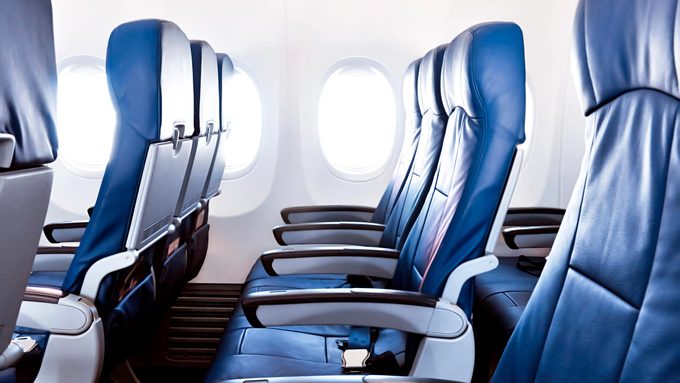It comes down to science and logistics

Why Are Most Airplane Seats Blue?

Unless you have a seat in first or business class for extra legroom, boarding and deplaning an aircraft can be stressful experiences. Because you’re so busy worrying about finding room in the overhead compartment and trying not to knock other passengers on the head with your personal item, you may not notice things like the plane’s interior color scheme. But if you pay attention the next time you board a plane, you’ll likely notice that its seats are blue.
Of course, there are exceptions to this—like Virgin Atlantic’s red seats and the green seats on Aer Lingus—but in general, airline seats tend to be blue. So why is that? We spoke to Rishi Kapoor, the founder and CEO of Nanak Flights and Sara Rathner, a travel expert at NerdWallet, to find out just why blue is the color of your favorite airline’s seats.
Curious why airplane seats are almost always blue? The reasons might just surprise you—some are more unexpected than you’d think.
Get Reader’s Digest’s Read Up newsletter for more travel, fun facts, humor, cleaning and tech all week long.
Why are airplane seats blue?
Even if blue isn’t your favorite color, that could change once you learn why it was chosen for airplane seats. Here’s what experts say are the top reasons behind this design choice.
Blue is easy to keep clean
There isn’t usually a lot of time to clean a plane between flights, so it’s in the company’s best interest to pick colors and fabrics that can handle a lot of traffic. According to Kapoor, many airplane seats are blue because stains or smudges can blend in better than with most other colors, meaning airlines don’t have to replace their seats as often.
Blue is a calming color
Even if passengers don’t have an outright fear of flying, the whole process can make even the most seasoned travelers a little anxious. To help counteract that, many airlines opt for blue seats because the color is thought to be calming.
“Even though traveling by plane is statistically the safest way to travel, many passengers are still prone to stress while traveling on an airplane,” Kapoor says. “It might seem like an insignificant detail, but it’s one that helps make flying the best way to travel.”
A statement from Boeing on using the psychology of color when designing aircraft confirms this, noting that blue is “nearly unanimously” associated with peace. In addition, Boeing selects the patterns for cabin walls based on those found in nature because “these designs help create the relaxing environment that people find in the outdoors,” Virginia Tripp, a Teague designer who studies color psychology said in the statement.
It makes you feel cooler
Planes tend to have two temperatures: bitterly cold (thanks to blasting air conditioning), or sweltering hot and stuffy (thanks to a large number of people being crammed into a flying tube with recirculated air). Airlines do try their best to help keep you cool—hence the sometimes-arctic air conditioning—and yes, blue seats play a role in that as well. “Colors also can influence a person’s perception of humidity, temperature and aroma,” Tripp explained in a statement from Boeing. Not only does the color blue make people feel cooler, but it also can send a message of clean or fresh fragrance.
Blue as part of branding
In some cases, the choice of blue for an airline’s seats is simply part of the company’s brand, Rathner tells us. “U.S. carriers commonly use blue and red in their logos as a nod to America, and blue seats are an extension of that,” she explains. Along the same lines, Frigo says that the color blue instills trust—a very important aspect of branding—which is why many dentists, banks and financial services companies have blue in their logo or color scheme.
Color Psychology, a website that explains the meanings behind different colors, confirms this, noting that blue helps instill feelings of trust, dependability and confidence. In addition, a 2011 study in the Journal of the Academy of Marketing Science found that the color blue is also associated with competence—something incredibly important for airlines, given that we put our lives in their hands every time we fly.
So the next time you’re crammed into the narrow aisle of an airplane trying to squeeze by your fellow passengers, take a look at the plane’s seats—chances are they’ll be blue, and ideally, they’ll do their job and make you feel calm.
RELATED:
- The Surprising Reason You Should Never Rest Your Head Against an Airplane Window
- What You Need to Know About “Gate Lice” at the Airport
- Here’s Why Flight Attendants Always Sit on Their Hands During Takeoff and Landing
About the experts
|
Why trust us
At Reader’s Digest, we’re committed to producing high-quality content by writers with expertise and experience in their field in consultation with relevant, qualified experts. We rely on reputable primary sources, including government and professional organizations and academic institutions as well as our writers’ personal experiences where appropriate. For this piece on why airplane seats are blue, writer Elizabeth Yuko tapped her experience as an expert commentator for Mysteries at the Museum (Travel Channel) and Beyond the Unknown (Travel Channel). We verify all facts and data, back them with credible sourcing and revisit them over time to ensure they remain accurate and up to date. Read more about our team, our contributors and our editorial policies.
Sources:
- Rishi Kapoor, founder and CEO of Nanak Flights
- Sara Rathner, travel expert at NerdWallet
- Springer Nature: “Exciting red and competent blue: the importance of color in marketing”
- Boeing: “The Psychology of Comfort in Airplane Interior Design”






















